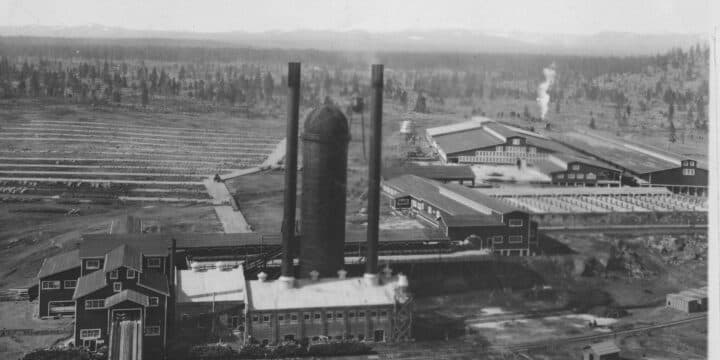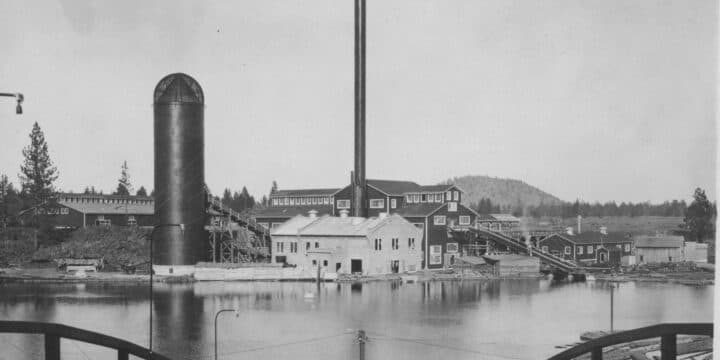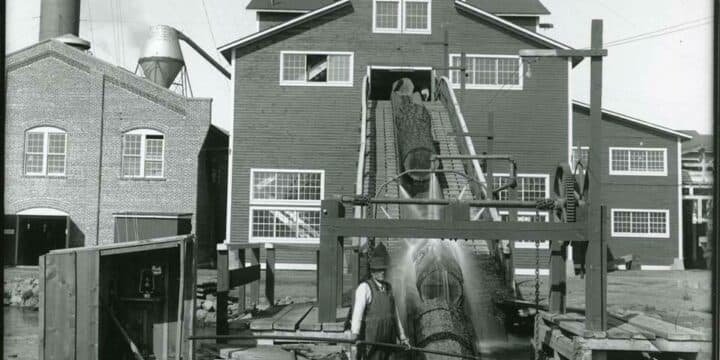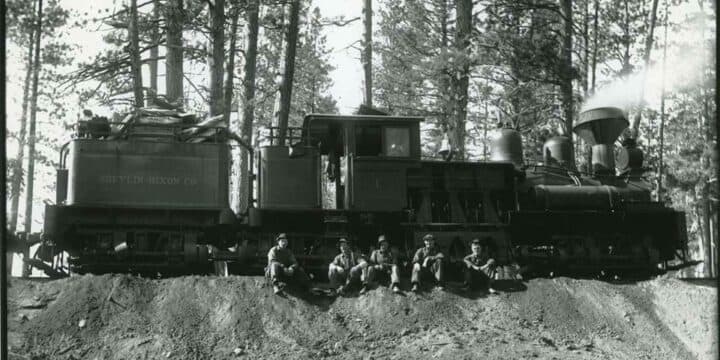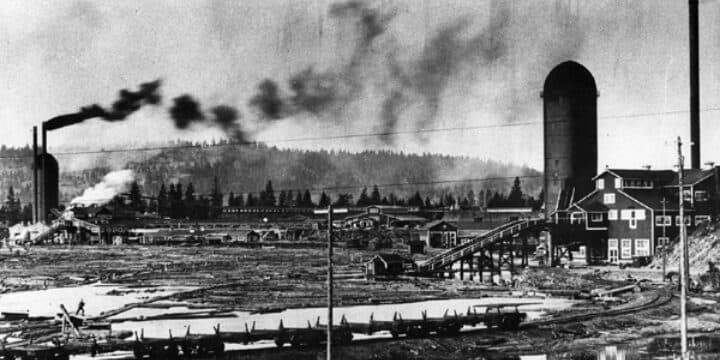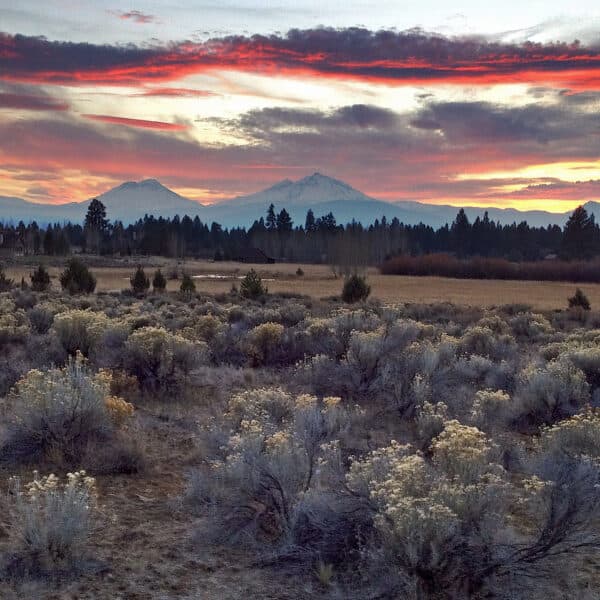
Timber to Tourism
Discover the storied history and modern transformation of the Old Mill District.
BY K.M. Collins
Since the state’s inception in 1859, Oregon and timber have been synonymous. Influential timber culture exists all over Central Oregon. The high desert showcases enterprises like Unofficial Logging Co., Lone Pine Coffee Roasters, Shade Tree Brewing and Timbers East (the last remaining in a chain of throwback Bend pubs named for each cardinal direction). In Portland, Oregon’s largest city, timber fever is noticeable with hallmark mascots and institutions like the Timbers Major League Soccer team, Stumptown Coffee Roasters, and the trendy music venue fan-favorite, Doug Fir Lounge. One only must look as far as the ubiquitous popularity of flannel button-ups to see how rooted the lumberjack woodsy lifestyle still is.
Initially growing in tandem with various West coast gold rushes and railway expansions in the 1800s, forestry has been one of the Pacific Northwest’s leading industries for more than a century. During this time, modern logging practices and conservation principles have taught the beaver state to better preserve its prized renewable timber resources. Flipping the lumber paradigm on its head, Central Oregon has stopped in its tracks, about-faced, and chosen to start keeping trees and forests wild and intact. As a result, while some of the industry’s boom towns have perished into ghost towns or urban sprawls, Bend has thrived.
The iconic Old Mill District has escaped what might have been a fruitless post-logging future by planting a fertile outdoor economy and cultivating thriving recreation attractions. This is the Cinderella story of how, through implementing restoration and strategic land development, an underdog logging community transformed into a national recreation mecca—with the Old Mill at the center of it all.
Shevlin-Hixon & Brooks-Scanlon Mills
Bend’s logging stronghold first began in March of 1916, when Shevlin-Hixon Lumber Company launched the first Central Oregon mill along the Deschutes River, just south of Downtown Bend. Only a month later, rival Brooks-Scanlon Lumber Company built their first mill on the opposite, east bank, followed by a second, larger, up-stream mill in 1922. This second mill complex makes up the largest portion of the Old Mill District today, including 11 historic buildings.
But why Bend for timber development? Before the mills were founded, the pine forests of Deschutes County were estimated to contain 26 billion board-feet of lumber resources. Seeking new timber holdings in the early 1900s, Brooks-Scanlon and Shevlin-Hixon companies came west by way of Minnesota. Although Shevlin-Hixon opened a mill first, by 1915 Brooks-Scanlon had purchased vast tracts of highly desirable ponderosa pine near Bend to supply logs to their sawmills. And the Deschutes River, which runs centrally through what is now called the Old Mill District, was a perfect thoroughfare for floating and transporting logs from upriver to the downriver mills. In fact, the bend in the river adjacent to the Old Mill District is the river feature Bend is named for.
Within eight years of operation, both companies had exhausted all their holdings and were looking to the Deschutes National Forest for a pipeline to fuel production. Archives show the volume of timber the Forest Service granted access to for milling was not sustainable and all parties knew it.
Despite this knowledge, by 1938, Oregon was the nation’s leading producer of wood with Brooks-Scanlon and Shevlin-Hixon super sawmill operations in Bend ranked among the largest on the planet. At their peak, each mill operated around the clock, employed over 2,000 workers, and produced millions of board-feet of lumber each year. From the start, much of the work pool were immigrants from Scandinavia and Eastern Europe as well as homesteaders gone bankrupt.
Since the mills were erected at the onset of World War I, one of the first products generated at the mills were ammunition boxes. With men away at war, box factories at both mills were staffed by women. In the post-war economy, timber needs only increased.
Though mill operations continued through the 90s, in 1950 unsustainable production came to a head. It was clear to all that the region could not support two super mills and Brooks-Scanlon acquired Shevlin-Hixon in a buyout.
To this day, Oregon produces more wood building materials than any other state.
Seeing the Forest for the Trees
Ultimately acknowledging the limitations in continued logging, Brooks-Scanlon diversified and established Brooks Resources Corporation, a land development company. Black Butte Ranch near the Metolius River was Brooks Resources Corporation’s first major project.
A key player in Bend’s shift toward recreation was a burgeoning businessman, Bill Smith, who worked on the Black Butte Ranch development for Brooks Resources Corporation. Legend has it, as Old Mill District Marketing Director (and history major) Beau Eastes explains, Smith visited the mills throughout the late 60s and early 70s and envisioned the area as a more desirable, natural, San Antonio Riverwalk with a high desert twist. When Smith was a nightwatchman during a mill strike, he cast a midnight rod into the then privately held riverfront and knew if the holdings ever became available, he’d want to develop the land and make it accessible to the community for angling and beyond.
Fast forward to the early 90s. The site, which now amounted to industrial waste and a collection of deteriorating buildings, changed hands several times until Smith organized a group of investors and acquired it through his company, William Smith Properties, Inc.
As the Old Mill District began to transform from a defunct mill space to a naturally beautiful community center, gaining mixed land use permitting to replace industrial zoning for the 270-acre plot was necessary. This glass-slipper move launched river restoration, trail planning, and other tourism development.
Eventually, after five years, permitting was granted. In restoring the Deschutes riverfront, 14,000 linear feet of river access was opened for the first time in 80 years. In a later effort, the Colorado Street spillway, or dam, was removed, which was increasingly posing a hazard to river paddlers and tubers. Instead of plugging the river with an artificial sieve, three channels, including a fish ladder, a recreation passage and a protected wildlife space were all installed. The fish ladder helps restore habitat and create a travel route for trout, avian, and mammalian riparian species. It’s not unusual to see ospreys, Canadian geese, ducks, great blue heron, beavers, muskrats, otters and other wildlife on this corridor.
A large network of paved riverside walking, biking, and skating paths were erected and connected to the larger bend trail network with the help of Bend Parks and Recreation. Interpretive signage lines these paths, which indicate historical markers and context, as well as art installations.
Deschutes Historical Museum Executive Director Kelly Cannon-Miller tracks the Old Mill District path from timber to outdoor tourism. She explains how one can observe the transition while visiting REI (Recreation Equipment, Inc.), a Pacific Northwest cornerstone outdoor brand located in the heart of the Old Mill.
“Today you can go and shop where the mills once stood. You can stand inside the old powerhouse of Brooks Scanlon Mill B, which is now an REI. For me it’s this great blend of two different things the forest has provided for the economy. Above the building you can see the smokestacks, and inside there is a huge beam that still reads Brooks-Scanlon. That’s the mill’s history. Then you look around and it’s all the equipment and gear you need for going out camping and enjoying the forest. It’s this great mixture of lumber history and recreation history all under this one historic roof.”
If you ask Smith, he would say Bend’s success in thriving post-lumber (where other timber towns haven’t) is “location, location, location.” Outdoor tourism is in our DNA because geography preordained it. “Cheek to jowl” or scrunched between public lands, Bend’s city limits have been constrained in growth while keeping a close proximity to the spaces residents like to recreate. This juxtaposition, Smith believes, is one of the most important determining factors.

Standing the Test of Time
During the Old Mill District’s upcycling restoration process, original structures and artifacts from Bend’s logging days were left intact. These charming relics of logging bygones are ripe for tactile and experiential learning.
Cannon-Miller shares, “Part of the Old Mill’s success is the commitment to a sense of character and design style in their architecture and design codes. While very few original mill buildings exist, new architecture conveys a sense of the industrial history of the area, with the powerhouse as its flagship structure and interpretive signs along its many walking paths speak to what came before.” She feels people respond to authenticity and the Old Mill is chock full of it. “Historic buildings provide a more authentic visitor experience to a town than the majority of new architecture. One only must look at the Box Factory on the edge of the Old Mill District to see the popularity of such locations.”
Where the East Coast embraces history with monuments like battlefields, cannons, and revolutionary lore aplenty, the Old Mill District seamlessly integrates logging fixtures like the quintessential towering smokestacks, enormous cement footings made over into flower beds, and antique saws as wall hangings, all woven in the fabric of contemporary shopping centers, eateries, and family outdoor recreation.
Old Mill District Yesteryear Highlights
REI Building
Home to the Old Mill District’s classic smokestacks, the REI building is made up of two historic buildings: Brooks-Scanlon’s powerhouse and the fuel building. Cannon-Miller points out that coincidentally, the powerhouse that relied on the forest for timber now supports a store that also relies on the forest for its clients.
Ironically, Smith was advised by many to remove the hazardous and would-be costly smokestacks. But ever the visionary, Smith saw them as a community wayfaring point—a powerful, distinguishing image that would be inseparable from Bend itself. Today, the smokestacks reign as a defining, invaluable local symbol of a transformed timber culture.
Saxon’s Fine Jewelers
Ninety years ago, this building housed wood scraps and timber byproducts to feed into Brooks-Scanlon’s powerhouse. Today it’s home to Saxon’s Fine Jewelers on the ground floor and Rapa Nui Tiki, Bend’s first tiki lounge, on the second floor. When Saxon’s moved into the space in 2006, the interior of the building was outfitted with tin ceilings, vintage light fixtures and wood flooring. Presently, wood beams, original brickwork and steel trusses highlight the past, as does a seven-foot-diameter saw blade in the building’s entryway.
DeWilde Art Glass
The oldest building in the Old Mill District affectionately known as the “Little Red Shed” houses the studio of glass artist Rich DeWilde. Originally located where Greg’s Grill is now, the Little Red Shed once held the mill’s firetrucks.
White House and Railcars
The “White House” was the former management office of the Brooks-Scanlon mill on the east side of the Deschutes River. It’s since been relocated to the back of the Hayden Homes Amphitheater to accommodate hospitality for talent. Behind the White House are four refurbished railcars once used at the mill. They now serve as dressing rooms and offices.
Tumalo Creek Kayak & Canoe
Tumalo Creek occupies what once was Brooks-Scanlon’s mill. Today, the cylindrical cement burner footing and the foundation of the mill’s powerhouse can still be seen on the back patio of Tumalo Creek Kayak & Canoe. The footings overflow with flowers each summer.
Art Station
Between 1911 and 1958, the current home of the Art Station was known as the Oregon Trunk Railroad Depot and served as the Bend train station near downtown. Though passenger service in Bend ended in 1958, the train depot was still used as office space. When planning for the Bend Parkway began in the 1990s, the station was forced to move. In 1999, the building was taken apart, stone by stone, and relocated to its current location on Shevlin-Hixon Drive across from the Hayden Homes Amphitheater railcars.
Box Factory
Just north of the Old Mill District and south of Downtown Bend, Killian Pacific purchased the 3.4-acre Box Factory site and 86,000-square-foot building in 2013 with significant renovations in mind. Originally built in 1916 by Brooks-Scanlon, it is called the Box Factory because it’s where scrap wood, rather than being burned, was recycled into a saleable commodity—boxes. Today, original wood beams, original siding, columns and rafters and concrete flooring are exposed throwbacks to the building’s lumber origins. Some spaces even retain the original, but decommissioned, deluge fire risers and original clerestory windows that cover a sizable portion of the roof and offer natural daylight.
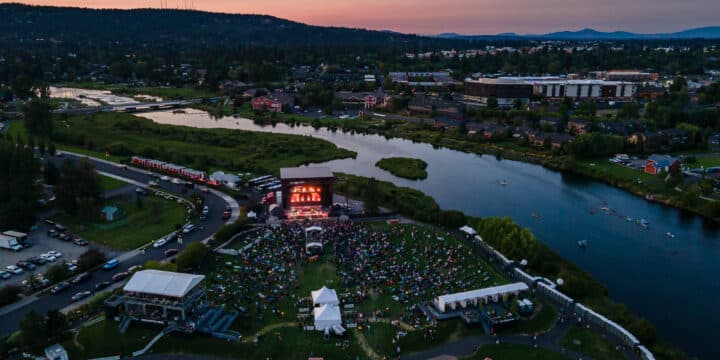
Recreation in the Old Mill District
To fully grasp the lay of the land during the peak of logging production in 1928, it was common for a person walking through town or the mill area to smell and find sawdust on their clothing. A person would hear periodic mill whistles and see smoke from the smokestacks and burners.
Traveling through the Old Mill District today is a drastically different experience. In many ways the Old Mill District is a microcosm of the rest of Bend—a quick bite-sized version of the extensive woodlands, mountain bike and hiking trails, and rafting and adventure that lies beyond the district’s stretches. It’s nature’s Disneyland for outdoor enthusiasts of all walks.
Hiking, Walking, and Biking
Pristine paved and maintained dirt trails crisscross through the Old Mill District and beyond. Enjoy the riverside trail littered with youngsters learning on training wheels, fishermen casting, and shoppers grabbing last minute outdoor gear for tomorrow’s adventure. Farther south and north of the Old Mill District, link up with Bend Parks and Recreation trails leading through quaint neighborhoods into Downtown Bend and into forests of ponderosa pine, sagebrush and wild rose.
Music
Hayden Homes Amphitheater, located on the west bank of the Deschutes River across from the main shopping complex, is an outdoor music venue and a crown jewel of the whole community. Hosting up to 8,000 people, shows range from comedy to hip-hop, bluegrass and classic rock. More than 20 shows a summer come through with increasing offerings on the horizon.
Cinema
Regal Old Mill Screen is the largest theater in Central Oregon and hosts all the new releases and blockbusters on your must-see list as well as local events like BendFilm Festival and numerous screenings.
Special Events
As a community centerpiece, the Old Mill District hosts yearly Bend events you may want to plan your visit around. WinterFest, Art in the High Desert, Bend Brewfest, the Pole Pedal Paddle, Oregon State University graduations, the Bend Marathon, community holiday celebrations, and more, are all highlights for locals and tourists alike.
Floating the River
In its logging heyday, the Deschutes River in the Old Mill District was filled with floating logs, such that a person could easily cross the river hopscotching on the trunks of floating trees. Today, instead of trees, mid-summer you will find inflatables and inner tubes filling the banks from Riverbend Park to Drake Park. If you want to join in the fun, find out how to rent a tube and hire a shuttle at one of the kiosks in the Old Mill District.
For More on Oregon Forestry
Deschutes County Historical Society
The Brooks-Scanlon collection at the Oregon Historical Society includes 137 boxes of canceled stock certificates, photographs, maps, blueprints, personnel records, transaction records and ledger books dating to the mid-1800s. See also the Historic Deschutes app.
Intertribal Timber Council, Portland, Oregon
Native American Forestry and Timber Resources management and directory.
Maxville Heritage Interpretive Center
Exhibits celebrate the rich and diverse multicultural history of Oregon's early logging communities.
World Forestry Center, Portland, Oregon
Exhibits, history, and education encourage champions of sustainable forestry.
